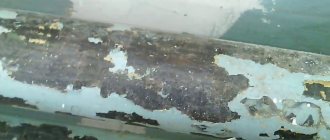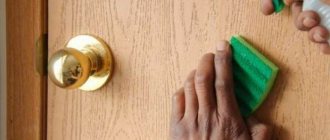One of the main tasks of any housewife is to maintain cleanliness in all corners of her home. Heating radiators are no exception. And many people fear how thoroughly they will have to clean old batteries, on which centuries-old dust has accumulated. But don’t worry, as useful tricks have long been invented to make life easier for clean people. In order to figure out how to wash heating radiators inside and out, you just have to read this article and learn all the most important things for yourself.
Why is it dangerous?
The sizes of dust particles are determined within the range from 0.00002 to 0.1 millimeters.
Above forests, rivers, and lakes, its content does not exceed 1 milligram per cubic meter. In cities, dust levels can reach 20 milligrams per cubic meter. The structure of dust in an apartment/house primarily depends on finishing materials, service life and quality of furniture and household appliances. The most common harm caused by household dust is allergies, which affect every tenth city resident. It is often confused with the common cold due to the similarity of symptoms. Allergies can result in bronchial asthma.
Dust allergies are primarily caused by saprophytic mites, insects up to 0.5 millimeters in size. In 1 gram of house dust there are up to 500 individuals that process organic dust components. Their waste product is guanine, an allergen that causes runny nose, conjunctivitis and asthma. In a city apartment, a person inhales 25 times more dust particles per minute than outside the city. Cleanliness in the house for city residents is important for maintaining health.
Long brush with curved brush
Sometimes it’s worth spending money on comfortable cleaning and buying a special brush-brush for cleaning hard-to-reach places. This brush with a curved ring penetrates perfectly into the battery, eliminating any kind of contamination. The peculiarity of its use is that you can reach those places where your hand could not previously reach. In a store of various household items for the home, such a device may be called a bottle brush.
When choosing the most convenient and affordable method for yourself, you need to remember that the dirt and dust that accumulates in the radiator cells is harmful to the health of households and pets, and can cause allergies and other diseases. That is why you should not bypass such hard-to-reach areas.
We use a steam generator
A steam generator will be a more modern alternative to a hairdryer and a rag. This equipment is ideal for cleaning old type radiators with many small cells. This universal device copes with any type of contaminant, while helping to disinfect radiators from the inside.
Before using the steam generator, it is necessary to place cloths under the battery to absorb water and moisture. If walls and floors need more reliable protection, then it is worth covering them with polyethylene or construction film. All that remains is to use the steam generator not exactly for its intended purpose, but according to the standard scheme!
For what?
Let's decide why we need to spend time and effort cleaning the radiator. Flushing is necessary in the following cases:
- During a tactile examination, you determined that the battery is heating unevenly - one part is colder than the other.
- Compared to other seasons, your apartment has warmed up an order of magnitude slower (especially if your neighbors don’t notice this in their homes).
- The heating main is hotter than the radiators.
- For private houses, energy resources for heating have increased, but heat transfer has remained the same or even decreased.
The bimetallic radiator takes the lead today.
Thus, without cleaning, your house will become colder and colder every season, taking into account the fact that you will pay the same money for heating.
Ways to quickly wash a battery
Let's take a closer look at what methods exist for washing cast iron, aluminum and bimetallic radiators.
Dry radiator cleaning
This method should be used at least once a year. As can be understood from the name, it consists in the fact that the heating device is cleaned superficially: from dust, cobwebs, crumbs and other light stains. The batteries inside are removed from debris using a broom, vacuum cleaner or dry cloth.
Wet cleaning of radiators
Carried out at least once every 2 years. This method will help get rid of greasy and stubborn stains. But before you start, you must do dry cleaning. Next, you will need to assess the degree of contamination: light, medium or severe. Because depending on this, you will be able to understand what auxiliary products and chemicals to use to quickly wash the batteries.
Tip #1
The cleanliness of the radiator must be constantly maintained, which will always allow you to quickly and easily clean its surface. At the same time, the device itself will last you much longer.
Tip #2
If there is a protective screen on the radiator, it must be removed before washing the cast iron or aluminum battery. The most effective way to clean the grill is to place it in the bathtub and wipe it thoroughly with a cloth soaked in soapy water. And then dry well with a clean cloth.
Tip #3
If the heating is turned off, it becomes possible to remove the radiator completely. Then you can soak it in a bathtub, having previously covered it with thick material to avoid damaging the enamel. Add detergents if necessary. Then the debris and dirt will come off much easier, you just need to rinse the sections with good water pressure.
Tip #4
When using wet cleaning, you should take care of the surrounding finish: wallpaper, laminate and parquet. Therefore, it is recommended to cover them with waterproof material. This could be oilcloth, film or an old unnecessary piece of linoleum.
Tip #5
The cast iron battery should be cleaned carefully. Since the surface of cast iron is uneven and has some defects that can injure your hands. It is better to clean with rubber gloves.
Tip #6
If the heating device has a completely unattractive appearance and cannot be washed, then all is not lost. Special acrylic paint will come to the rescue.
Tip #7
When using various chemicals or boiling water, you should think about the safety of your hand skin. Namely, wear thick rubber gloves.
Seven ways to clean your battery from dust
- A vacuum cleaner with special narrow attachments is the fastest and most effective way to clean cast iron or steel radiators;
- Instead of a vacuum cleaner, you can use a steam generator, which not only cleans, but also disinfects. To do this, place rags under the radiator that absorb water well. Or, to protect the walls and floor, you can first lay or hang an oilcloth, and lay a rag on top. Then treat the heater with steam;
- Place a wet cloth on the wall behind the battery and use a hair dryer to blow the dust off the device. Then the dust will settle on the rag;
- You can wash the battery without using additional equipment. In this case, use manual cleaning and cotton gloves. Put gloves on your hands and soak them in a soapy solution, then use your hands to clean the dirt and dust from inside the device;
- You can clean the battery using boiling water. To do this, take a baking sheet from the oven, a kettle of boiling water and a bucket of rags. Place the baking sheet under the radiator, and start pouring boiling water over the device itself. During cleaning, you can additionally wipe the battery with a cloth. When working, use rubber gloves and be careful with boiling water! Water and dust will drain into the pan. And as the pan fills, pour the water into the bucket and put it back. After the procedure, thoroughly wipe the radiator with a damp and then a dry cloth, and remove any splashes around;
- Heavily dirty heating appliances can be washed using special cleaning products. Household chemicals effectively remove dirt, dust, grease and plaque. First, rags are placed under the battery, and then the spray is sprayed over the surface of the radiator and left for the time specified in the instructions. After this, wipe the battery with a sponge or cloth;
- To properly clean the inside of the battery, use a dish brush with a curved end, a long-handled radiator paint brush, or an old toothbrush. This way, you will reach hard-to-reach places, you will be able to completely wash the device, and effectively and permanently remove dust.
Best answers
Mikhail Zolnikov:
Place a large damp cloth behind the battery. Take a hair dryer, turn it on full power and blow through the radiator. If the dust still does not blow away, go over the battery with a brush or toothbrush. If the vacuum cleaner supports the function, you can plug in the hose for blowing and blow it out with a vacuum cleaner.
Leave the Soviet batteries. I changed it and now I regret it. To make them warmer, it is fashionable to treat the surface of the battery with PAINT DESTRUCTOR liquid, it will eat off all the paint in half an hour, scrape off the scraps of paint with a spatula, prime and paint. Previous layers of paint act as thermal insulation.
I would recommend installing taps on the connections to the battery - when the apartment is hot, you can turn off the battery with this tap. This is especially true in April-May, when it is warm outside and the radiators are hot.
Liliya Chudinova (Tikhonova):
vacuum cleaner, no? ? I clean mine like this, with a narrow nozzle and everything is ready.
Julia))):
Handles... Take a rag and wash it. That's the whole secret.
Verochka - Kind Soul:
I agree with Mikhail... And I myself just wipe it with a damp cloth and a brush...
*~*Green-Eyed Beauty10000*~*:
Toothbrush and damp cloth)))
Happy *))):
I have a Karcher steam cleaner. Ideally copes with this kind of work. And so only with a brush.
pa44a pa44a:
toothpaste + glass cleaner, and a rag.. ideal!!
Algorithm for proper cleaning
Cleaning begins with putting things in their places. Items that are not regularly used are put away in cabinets, pantries, and shelves. Before removing or packing, dust must be removed from things:
- wipe;
- wash;
- vacuum;
- knock out.
To avoid mold, shoes, clothes, carpets, and soft toys should be dried, preferably in the sun. After tidying up the interior, you need to vacuum the floors so that dust does not rise into the air during cleaning.
Anti-dust treatment begins with textiles:
- curtains;
- curtains;
- bed linen;
- upholstered furniture;
- toys.
They are washed or treated with a steam generator.
Carpets and rugs are washed with foam and dirt is removed with a vacuum cleaner. The cleaning procedure can be carried out outdoors. It is easier to remove dust from dried products.
The next stage of cleaning is the most inconvenient. Need to wipe:
- corners and space between walls behind the refrigerator, cabinets, washing machine;
- ceiling;
- cornices;
- the top of the cabinets.
Whitewashed ceilings are brushed or vacuumed. Dust from the walls can be brushed off with a broom, sockets and switches are wiped, ventilation grilles are washed.
Then washed:
- doors (indoor and outdoor);
- pens;
- windows and window sills;
- chandeliers, sconces, table lamps;
- air conditioning filters;
- air conditioner;
- hood;
- mirrors;
- body of a refrigerator, washing machine.
Wipe clean using polishes or surface sprays:
- shelves (internal and external);
- furniture doors, walls;
- computer monitors;
- TV screens.
Leaves of indoor flowers are cleaned of dust. Give moisture-loving plants a shower. Before the final cleaning procedure, dirt is removed from under the beds. They vacuum again. The filters of the device are washed/replaced. All parts and surfaces of the vacuum cleaner are wiped. Wet cleaning is done throughout the entire room.
Cleaning from the inside
Batteries become dirty not only from the outside, but also from the inside: scale, rust, and mold settle on their walls. Basically, deposits of internal scale attach to the bottom of the battery, blocking the normal flow of water. Plaque inside reduces the flow of heat into the house.
How to clean deposits inside:
- Close the valves.
- Unscrew the nuts that secure the battery.
- Carefully drain the water.
- Remove the battery and take it out into the open, or at least into the bathtub (cover the enamel with a thick cloth).
- Using a wooden hammer, gently tap the entire battery to remove any adhering residue.
- Shake out any solids.
- Fill the tank with hot water for half an hour. To speed up the peeling of plaque, add a little citric acid or soda to the water. There are special washing solutions.
- Use a hose to rinse the inside of the battery. Continue until the water flowing out is completely clear.
Radiators should be flushed after the end or before the start of the heating season.
By paying attention to external and internal cleaning of heating radiators, you thereby extend their shelf life and improve the heat supply to the apartment. Even minimal effort will be useful
Preparing for washing
Do not be mistaken that this is easy to do, especially when it comes to cast iron. But if you approach the situation wisely and your hands “grow from where they should”, two men will cope with the task.
Preparation technology:
- It is better to choose a day before mid-autumn, when services have already purged the main line, but water has not yet been released into the system. Ideally, you need to clean the batteries of all neighbors in the riser at the same time. Otherwise, dirt in a radiator located in another apartment will end up in yours, and the procedure will become useless.
- Draining water from the system in a private home is not difficult and can be done at any time. In an apartment building, you will have to negotiate with a plumber to carry out all the manipulations in the basement, where the distribution center of the house is located. You need to notify your neighbors if this happens during the heating season. Although the latter is resorted to when there is a blockage. It is better to carry out routine cleaning of radiators in the summer.
- If you have only superficial knowledge about the operation of batteries, their connection to the system and other nuances, it is better to first study the hardware. Or call a professional.
- Prepare a container in advance where the remaining liquid will drain.
- After unscrewing the element, you need to remove it. At this stage you will need an assistant. Even a bimetallic product is inconvenient to dismantle alone.
- The coolant should be inspected. Maybe there is no point in cleaning it anymore.
- If you plan to wash the product with water in the bath, you need to put something under it. For example. silicone mat. Otherwise, the scratches on the tank will be so serious that you will then have to pay for the restoration of the bathtub.
Tip: If the joints are welded, you need to use a cutter or other tool to heat the coupling.
Work order
Before you begin directly removing dirt, you need to remove the protective screen, if any. The grate must be washed by placing it in a bathtub using warm running water. After the procedure, you need to wipe it dry with a dry piece of soft cloth. If there are significant stains, a soap solution will help remove them.
Using a vacuum cleaner
Dust that has accumulated between the body parts can be easily removed with a vacuum cleaner. To do this, you need to use a narrow nozzle, since with their help you can remove even the most inaccessible places.
Using a hair dryer
This method of dust removal is also effective. To do this, place a wet cloth on the wall located behind the radiator. This could be a diaper or an old pillowcase. To prevent dust and dirt from remaining on the wall, cover it with film and then attach the fabric. After this, you need to thoroughly blow the entire battery with air from a hair dryer. This will help blow away dirt and dust, which will then settle on the wet cloth. This cleaning method is suitable for frequent use, especially if the radiator does not have stubborn stains. The time required for this type of cleaning is about 10 minutes.
Using boiling water
This method is suitable for cleaning the radiator from significant stains. To do this you will need a wide baking tray, a kettle of boiling water and a rag. The container in which the water will be collected must be placed under the device, and the wall located behind it must be covered with film.
Next, you should very carefully pour boiling water over the battery. It will help wash away dirt that drains into the container.
Vacuum cleaner or hair dryer
House heating radiators are good at collecting dust and dirt, especially since housewives often forget about this part of the apartment when cleaning. It is important to understand that any type of radiator will sooner or later have to be cleaned, regardless of the material from which it is made.
For dry cleaning, use a vacuum cleaner with narrow brush attachments designed for furniture. Or go the opposite way and “blow” all the dirt out of the battery crevices using a hairdryer. To prevent dust from moving through the air, place a damp cloth between the wall and the radiator or ask someone to hold it during the procedure.
Always start cleaning the radiator with a vacuum cleaner or hair dryer, and then proceed with wet cleaning if necessary.
Battery cleaning brushes and sponges
To remove old stains, the following will help:
- A toothbrush, brush or narrow paint brush with stiff bristles. They are able to crawl into the most remote corners of the radiator.
- Sponge. If you attach it to a long ruler, it can also clean hard-to-reach places.
- Rubber glove. You need to put it on your hand and wash it well with laundry soap. Then rub off stubborn stains on the heater using your fingers. Can be replaced with old cut-off tights or socks.
- Dishwashing brush. Use this brush to clean the battery. They are sold in hardware stores and have a comfortable long handle.
- Spray. In order to wash the inside of old batteries, you need to add detergent to the spray bottle and spray the dirt. Wait a while and wipe the soaked areas with a damp cloth.
Gloves
An ideal and quick way to clean bimetallic batteries from the inside. The openings between the blocks of such a radiator are very narrow, so using a sponge or rag is not always effective.
To clean a modern bimetal battery quickly, follow these instructions:
- Take cloth household gloves, not necessarily new ones.
- Wet them and soap them well. It is recommended to wash the radiator with laundry soap, shampoo or dish gel. It is better not to use abrasive powders.
- Wear gloves and thoroughly clean all spaces between sections and the batteries themselves. It is very convenient to feel all the dirt and crevices with your hands.
- Remove the soap layer also using gloves.
- Repeat the procedure several times if necessary.
Tip: If you don't have gloves, use an old sock.
Cleaning products
To clean the battery, you can use special chemicals or get by with natural substances, which are sure to be found in the arsenal of any housewife. Using these products will significantly reduce cleaning time and save your energy.
Natural remedies:
- Lemon acid. 3 teaspoons per two hundred gram glass is enough to wipe dusty areas with this solution.
- Hydrogen peroxide. Its bactericidal properties will cope with pathogens that have accumulated on the radiator.
- Vinegar will help deal with unpleasant odors in the house. Undiluted distilled vinegar will remove mold from your heating system. A solution of a liter of water and two hundred grams of vinegar will make the surface shiny.
- Baking soda copes with heavy stains not only on dishes, but also on the radiator. Soda diluted in water removes contaminants in hard-to-reach places of the heating device. Soda can be diluted with apple cider vinegar and a soap solution - the result will be more effective.
- Chalk diluted in water.
Chemicals:
- Oxygen bleach: Vanish or DeLaMarc.
- Liquid and powdered anti-greasy agents: Pemolux, Proper, Comet. Vanish, Kalgin, Tiret, Silit, Sorti, Fairy, Stichonite, Domestos. There is a huge selection of universal cleaning products.
- Powders. The powder is diluted in clean water, the battery is wiped with a soft cloth.
- Soap. Soapy water works well to remove dirt in hard-to-reach places.
Chemicals are also often actively used to clean cast iron pipes before painting. To prevent rust, you can use products that prevent its occurrence.
It is important to avoid using products containing chlorine and phosphates. These substances are harmful to the body
Causes of dirt
In centralized heating systems it is difficult to check the quality of the coolant. Various foreign impurities are found in the water circulating through the network. Therefore, heat pipelines also need to be monitored and maintained in proper condition. There are often areas where pipes have been standing for 10 years, or even more. And during this entire period, corrosion processes occur in the system.
Hot water is supplied under pressure, breaking off pieces of rust from the inner surface of the pipes. It is these elements that then go to the radiators, where they settle on the walls.
Thus, the channels of heating devices become clogged with impurities, debris and rust during their service life. This leads to a decrease in the amount of coolant that can pass inside the pipes. As a result, the heating efficiency deteriorates. And even if the coolant heats up to high temperatures, this will not change the situation much.
Don’t know how and how to clean radiators? Read!
If the radiator becomes cold during the heating season, then it is necessary to flush it, since during operation, debris has accumulated in it and the coolant has stopped circulating through the system. But before we find out how to clean radiators, let’s figure out why a cast iron radiator gets clogged.
How and what does a heating device become clogged with?
Since the quality of the circulating fluid sometimes changes, this leads to mechanical particles settling in the heating system, which move along with the coolant. And after the season, the water is drained, and corrosion occurs in the pipes.
When hot water is supplied, since it is under a certain pressure, corrosion particles peel off and also settle inside the radiator. And over the years, so much of this garbage accumulates that, circulating along with the coolant, it clogs the heating battery. All this leads to the fact that the device stops working efficiently, and even with a hot riser, the radiators remain warm, and this is the first signal that the battery needs to be cleaned.
Advice from experts
If you do not have the skill to work with wrenches, then you should not wash the heating device yourself. Let's look at how to clean a heating battery correctly.
For this:
- In places where there is a surge on the radiator (top and bottom), unscrew the lock nut;
- Hold the coupling with one key, and screw the squeegee into the heating battery with the other. This is done until he comes out;
- Free the radiator from the pipes and remove it from the holders;
- The battery is mechanically cleaned of debris and deposits, but if this does not work, then various chemicals are used to remove scale;
- After the inside of the radiator is cleared of debris, it is blown out with compressed air;
- If the battery is aluminum, then hydrodynamic flushing is necessary;
- After cleaning, the heating device is mounted back in its place. To do this, hang it on brackets. Unscrew the fittings and clean the threads from the seals. A cable or sealing tape is wound around the long thread and screwed into the radiator. Before this, screw the locknut to the end of the thread. The same action is performed with the second drive;
- Simultaneously with unscrewing the squeegee, screw it into the tap or coupling, and there should be a seal at its end;
- Also, a sealant is wound in front of the locknut.
A few tips on how to flush radiators
It is important! Let's look at ways to clean cast iron heating appliances; this work is not difficult. You can flush the radiator using soda ash, whey, vinegar essence and other preparations.
Basic steps when flushing the battery:
- Dismantle the radiator;
- Soda is poured into hot water and poured into the heating system;
- The plugs are screwed in at both ends of the battery;
- After some time (1 hour), the radiator is shaken, and in order for the rust to come off, the body is tapped with a wooden hammer;
- Open the plugs and connect the hose and open the tap, and the pressure must be high so that all the rust comes out;
- In order to create high pressure, you can use a compressor.
Cleaning with liquid for a car radiator
- Read her instructions and accordingly give her the required dosage;
- This product is poured into the radiator and filled with hot water, but not completely;
- At intervals of 10 minutes, the heater is turned (within two hours);
- After this, the battery is washed under high pressure of water until the corrosion particles completely disappear.
How to clean a radiator with whey?
- It is poured into the battery and, just as when using soda ash, the system is turned and tapped, as the serum should be shaken;
- This substance contains an acid that eats away rust and cleans the heating device.
Conclusion
The article discusses how to clean a cast-iron heating radiator, but to avoid having to do this, you can make a small outlet with a plug and attach magnets to it, which will attract rust.
And to remove corrosion particles, you need to open the plug and remove the residue.
ActionTeaser.ru - teaser advertising
Conclusion
Now you know how to wash an accordion heating radiator inside and out, what products, devices, and household appliances will be useful in your work.
We welcome your responses and comments. Write how useful this publication was. Each house and apartment has its own individual smell. Unfortunately, sometimes it becomes stale and not very pleasant, and a stink appears. Specialists from the cleaning company Mactailor share with you tips on how to remove odors from your apartment.
How to clean a radiator from dust
Heating radiators very quickly accumulate dirt and dust, especially inside. This disrupts the aesthetics of the room, interferes with the proper operation of the heating device and reduces the efficiency of heat transfer, causing corrosion, grease and salt deposits.
In addition, dust negatively affects human well-being and often causes an allergic reaction.
Regular battery cleaning is the key to human health and excellent preventive maintenance of heating devices. However, while removing dust from the outside of the radiator is quite easy, cleaning the inside causes a lot of hassle and problems. Let's find out how to quickly and effectively clean the inside of radiators from dust. And let's look at how to properly clean radiators.
Seven ways to clean your battery from dust
- A vacuum cleaner with special narrow attachments is the fastest and most effective way to clean cast iron or steel radiators;
- Instead of a vacuum cleaner, you can use a steam generator, which not only cleans, but also disinfects. To do this, place rags under the radiator that absorb water well. Or, to protect the walls and floor, you can first lay or hang an oilcloth, and lay a rag on top. Then treat the heater with steam;
- Place a wet cloth on the wall behind the battery and use a hair dryer to blow the dust off the device. Then the dust will settle on the rag;
- You can wash the battery without using additional equipment. In this case, use manual cleaning and cotton gloves. Put gloves on your hands and soak them in a soapy solution, then use your hands to clean the dirt and dust from inside the device;
- You can clean the battery using boiling water. To do this, take a baking sheet from the oven, a kettle of boiling water and a bucket of rags. Place the baking sheet under the radiator, and start pouring boiling water over the device itself. During cleaning, you can additionally wipe the battery with a cloth. When working, use rubber gloves and be careful with boiling water! Water and dust will drain into the pan. And as the pan fills, pour the water into the bucket and put it back. After the procedure, thoroughly wipe the radiator with a damp and then a dry cloth, and remove any splashes around;
- Heavily dirty heating appliances can be washed using special cleaning products. Household chemicals effectively remove dirt, dust, grease and plaque. First, rags are placed under the battery, and then the spray is sprayed over the surface of the radiator and left for the time specified in the instructions. After this, wipe the battery with a sponge or cloth;
- To properly clean the inside of the battery, use a dish brush with a curved end, a long-handled radiator paint brush, or an old toothbrush. This way, you will reach hard-to-reach places, you will be able to completely wash the device, and effectively and permanently remove dust.
How to remove and wash the battery from the inside
For general cleaning, experts recommend removing the battery and taking it out of the room, as this procedure causes a large amount of dirt and debris to appear. Cleaning is done outside or in the bathroom, after covering the bathtub with a thick cloth so as not to damage the enamel of the plumbing fixtures.
By the way, read here how you can restore the enamel of a bathtub. A protective mesh is inserted into the drain hole to catch solid particles and prevent clogging of the pipeline.
Before starting the process, be sure to turn off the valves and unscrew the nuts that attach the radiator to the heating network pipes
Then you should carefully drain the remaining water, remove the battery from its mounts and place it in the bathroom
Wash the device using a shower or hose.
To clean a radiator, take a mallet, hammer or wooden block and tap each section thoroughly. This will speed up the removal of rust and salt deposits. Then tilt the appliance on its side and shake it to release large solids from inside.
After this, pour hot water inside the radiator and leave for half an hour. After the time has passed, rinse using a shower or hose. Flush the battery until the water coming out from inside is clear.
Most often, batteries are not cleaned inside for several decades. Therefore, washing with ordinary water may not cope with contaminants. In this case, you can use additional funds.
So, soda, citric acid or acid-base compounds are added to the washing water. Before using special detergents, carefully read the instructions, as some have a negative effect on aluminum and are not suitable for aluminum batteries!
Removing contaminants using electrical appliances
There are several ways to wash the outside of batteries quickly and effortlessly.
- Use an ordinary vacuum cleaner (or for a car) and narrow nozzles that are included in the kit. To remove dust and cobwebs in the most inaccessible places of batteries, this method can be used during daily or weekly cleaning of carpets or rugs. This will prevent the accumulation of dirt.
- A hairdryer is also suitable for removing dust and cobwebs in hard-to-reach places on a heating radiator. Just first you need to place a damp cloth behind it, which will prevent dust from flying around the rooms when blown out.
- You can use a steam generator or steam mop, only before processing the finishing materials around, cover with rags that absorb moisture well.
- A washing vacuum cleaner is also a good helper in washing the outside of batteries. But it requires additional preparations so as not to flood the neighbors. Before cleaning, you should put a waterproof material behind the radiator so that the wallpaper on the wall does not get wet. Place a container for water and a fabric that absorbs moisture on the floor.
Cleaning correctly is important!
Dust repellents only help when used correctly. First of all, you need to learn how to clean consistently.
How to wipe off dust correctly?
- You should move from top to bottom. First you need to wipe the chandeliers, baguettes, cabinets, and then the furniture and floor. If you do the opposite, dust from the upper tiers will fall down and cover already processed objects.
- You need to use a slightly damp cloth - this will collect dust most effectively. If you wipe it with a wet cloth, streaks will remain; if you use a dry cloth, dust particles will scatter throughout the room.
- Before wet cleaning, dry cleaning is carried out. You must first sweep the floor, vacuum the carpets and furniture. Then there will be fewer suspended particles in the air, and surfaces can be wiped clean.
Efficient devices and special equipment
Special cleaning supplies and household appliances help combat dust in your apartment. Let's list the most effective ones:
- Wipes with antistatic effect. First of all, they are designed to eliminate dust and static electricity from screens and various types of equipment. But they can also be used to wipe cabinets, shelves, mirrors and other surfaces.
- Microfiber cloths. It is best to collect dust and prevent it from flying around the room.
- Vacuum cleaner. A universal device for dust control. Devices with various attachments, washing devices, and a steam generator help eliminate it especially effectively. They are able to clean hard-to-reach places, deep layers of fabric, upholstered furniture, carpets, toys.
- Washers and air purifiers. Devices designed to filter air also collect dust. They trap harmful particles inside themselves, as a result of which you have to clean the apartment less often. Some varieties even have a dust sensor, in particular Xiaomi Mi Air Purifier 2.
Signs of blockages
It is known that scale no more than one millimeter thick can reduce the level of heat transfer by 15%. As a result, the cost of heating the apartment increases, but there is no effect.
The presence of contamination is accompanied by the following signs:
- When heating radiators are supplied, they warm up more slowly than before;
- some sections of one radiator are colder than others;
- the temperature of the riser is higher than the radiators in the room;
- the house is cooler than the neighbors;
- The battery heats up unevenly: the top is warmer than the bottom.











